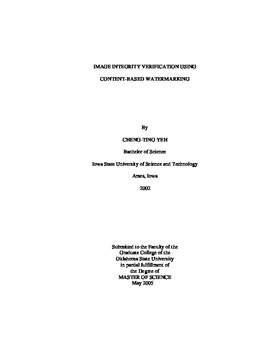| dc.contributor.author | Yeh, Cheng-Ting Eddy | |
| dc.date.accessioned | 2014-04-15T18:33:23Z | |
| dc.date.available | 2014-04-15T18:33:23Z | |
| dc.date.issued | 2005-05-01 | |
| dc.identifier.uri | https://hdl.handle.net/11244/8271 | |
| dc.description.abstract | Digital watermarking is a technique to insert an information-carrying digital signature into a digital media so that the signature can be extracted for variety of purposes including ownership authentication and content verification. In recent years, the popularity of the Internet and increase of sophisticated image processing tools commercially available today have created opportunities for malicious parties to intercept images, modify its content, and then transmit the forgeries to their respective receivers, where alterations resemble closely to the work of professionals and are undetectable by the human eye. For this reason, in order to reduce the constant proliferation and threats for digital media in the World Wide Web, digital watermarking is one of the crucial techniques to protect the contents of products in digital form and enable copyright or ownership information to be embedded into the multimedia data. The purpose of this study was to examine the weaknesses against common watermarking attacks of blockwise independent and content-based watermarking algorithms for image integrity verification and implement a new and more secure invisible fragile watermarking technique for color or grayscale images that increases the message digest size from the proposed 64 to 128 bits using the same small-size blocks and maintaining accurate localization of image changes. Our watermarking technique is capable to detect any changes made to the image since the time it was stamped, any changes to the pixel values and also to the dimensions of the image will be automatically detected and localized. Our scheme consists of a watermark insertion process that uses a private key to embed a watermark image into a cover image, and a watermark extraction process that uses a public key to extract the watermark from the watermarked image. The embedded watermark can only be extracted by someone who has possession of a proper verification key. This implies that someone who does not have a valid key will not be able to forge a watermark that will pass undetected. Finally, our technique provides means of ensuring data integrity; adds more security to the contents of digital media and allows recipients of an image to verify its authenticity with ease as well as display the ownership information embedded within an image. | |
| dc.format | application/pdf | |
| dc.language | en_US | |
| dc.publisher | Oklahoma State University | |
| dc.rights | Copyright is held by the author who has granted the Oklahoma State University Library the non-exclusive right to share this material in its institutional repository. Contact Digital Library Services at lib-dls@okstate.edu or 405-744-9161 for the permission policy on the use, reproduction or distribution of this material. | |
| dc.title | Image Integrity Verification Using Content-Based Watermarking | |
| dc.type | text | |
| osu.filename | Yeh_okstate_0664M_1306.pdf | |
| osu.college | Arts and Sciences | |
| osu.accesstype | Open Access | |
| dc.description.department | Computer Science Department | |
| dc.type.genre | Thesis | |
| dc.subject.keywords | image integrity | |
| dc.subject.keywords | fragile watermark | |
| dc.subject.keywords | content-based watermarking | |
| dc.subject.keywords | public-key watermarking | |
| dc.subject.keywords | watermarking | |
